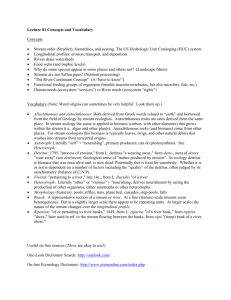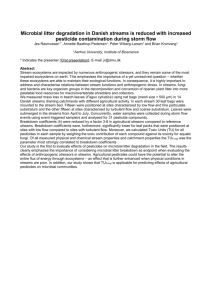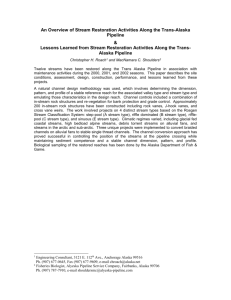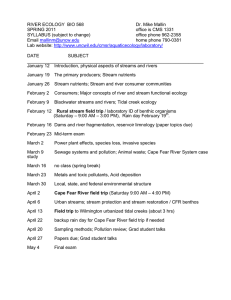FINAL REPORT TO WATER RESOURCE S RESEARCH INSTITUT E
advertisement
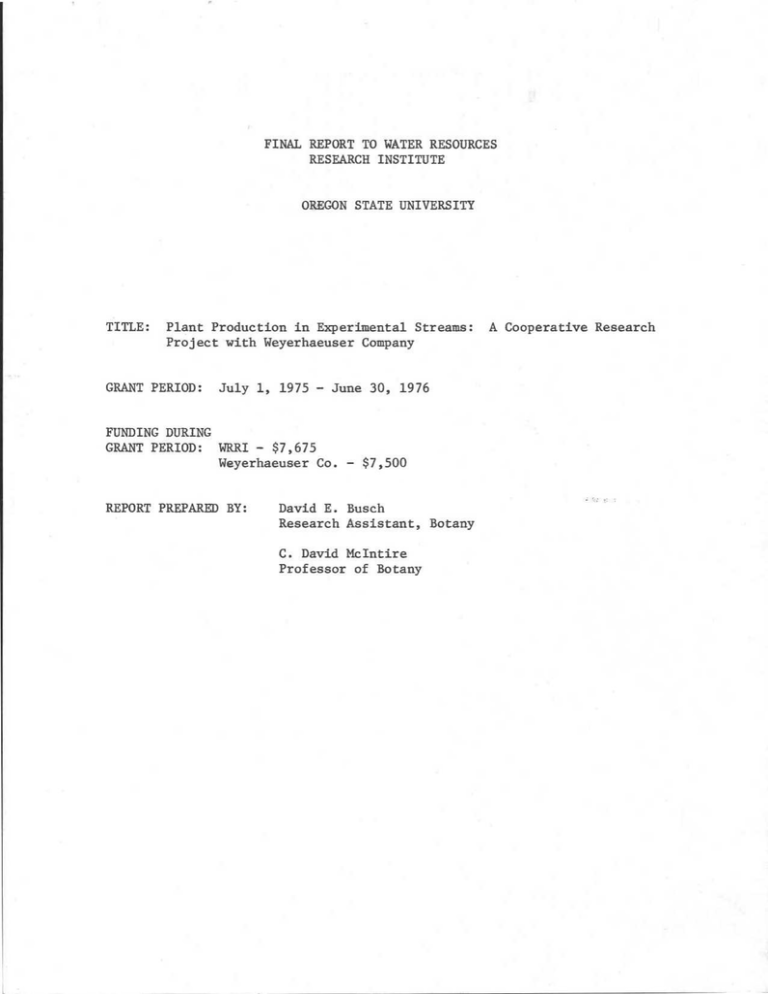
FINAL REPORT TO WATER RESOURCE S RESEARCH INSTITUT E OREGON STATE UNIVERSIT Y TITLE : Plant Production in Experimental Streams : A Cooperative Researc h Project with Weyerhaeuser Company GRANT PERIOD : July 1, 1975 - June 30, 197 6 FUNDING DURING GRANT PERIOD : WRRI - $ 7,67 5 Weyerhaeuser Co . - $7,500 REPORT PREPARED BY : David E . Busc h Research Assistant, Botan y C . David McIntir e Professor of Botan y FP .w1 ;a ; _ 1 ~C Y•~'r [ ■h..‘w)zt -N16 IMF INTRODUCTIO N During the winter of 1974, representatives of the Research Departmen t of Weyerhaeuser Company contacted C . David McIntire, Department of Botan y and Plant Pathology, for the purpose of establishing a cooperative researc h program at the Compan y ' s experimental stream facility, about eight mile s northwest of the town of Cougar, Washington . This facility was constructe d by Weyerhaeuser Company on the St . Helen ' s Tree Farm in 1964 . The genera l objectives of research conducted at this experimental station are : (1) t o provide a contribution to the fundamental knowledge of stream processes ; (2) to investigate ways in which productivity can be managed in fresh-wate r streams to enhance their value to man ; and (3) to study the effects of th e Compan y ' s forest management strategy on water resources . Research in th e experimental streams has been underway since 1965, and the initial wor k emphasized life history studies of aquatic insects and fish . Investigators in the Research Department of the Company at Longview , Washington, have recognized the importance of beginning experiments t o help understand patterns of energy flow in lotic (stream) systems as such patterns relate to the activities of man . Of particular interest to th e Company is the effect of nutrient enrichment on the bioenergetics of strea m organisms . The experimental streams are autotrophic systems, the dynamic s of which are essentially controlled by the rate of primary production and the properties of the algal assemblages that grow in these systems . It wa s a need for professional assistance in the areas of primary productivity an d algal taxonomy and ecology that prompted the proposal by the Company for cooperative research project with the Department of Botany and Plan t Pathology at Oregon State University . a 2 The initial funding period for this project was supported by th e Weyerhaeuser Company and covered the period from September 1, 1974 t o August 31, 1975 . In the early part of 1975, it became apparent tha t additional funding for some equipment items, supplies, and computer time woul d contribute to the success of the project and enhance the cooperative arrange ment with the Weyerhaeuser Company . At that time a proposal was submitted t o the Water Resources Research Institute, Oregon State University, for a modes t sum to help us supplement the very limited resources available for thi s project . We are sincerely grateful to the Institute for their suppor t during the period from July 1, 1975 through June 30, 1976 . It is quit e probable that the additional funds from Oregon State University provide d the stimulus for two additional years of funding from the Weyerhaeuse r Company (through summer of 1977), and that a project originally funded a t $7,500 has, in fact, been expanded into a program with total suppor t slightly over $31,000 . 3 DESCRIPTION OF EXPERIMENTAL STREAM FACILIT Y The Experimental Stream Facility is located on the Weyerhaeuse r St . Helen's Tree Farm in the Cascades, about eight miles northwest o f the town of Couger, Washington . The elevation is about 1,200 feet, an d the snow cover can vary from a few inches to almost four feet durin g the period from December through March . The study area includes abou t five acres and is adjacent to the Kalama River . The site is surrounde d by a nine-foot fence, and the terrain slopes gently towards the river . The soil is of volcanic origin with large pyroclastic rocks overlyin g finely-divided pumice . There is a single building on the site wit h living quarters and a small laboratory area . A large natural spring provides the water for the experimental streams . The water flows over a weir into a distributing pond and from there to eac h of three stream beds . The volume of water which flows into each stream varies from about 0 .5 c .f .s . in the fall to 0 .8 c .f .s . during the winter . The streams are four feet wide and range in length from 400 to 700 feet . The streams consist of a series of riffles and pools, and the stream bed s are filled with small stones (0 .75 to 1 .5 inches) covered by larger rubble . Water velocity in the streams varies from about 1 to 1 .75 feet per second , depending on the gradient . RESTATEMENT OF OBJECTIVE S The general objective of this research project is to determine th e effects of nutrient enrichment and other environmental changes on rates o f primary production and on the structure of algal communities in experimenta l streams . Nutrient enrichment--primarily nitrogen-will simulate introductions 4 related to forest management policies practiced by Weyerhaeuser Company , namely forest fertilization and nutrient introductions resulting fro m logging activities . Effects of shading on plant production also will b e monitored and related to the Company's management policies . Results o f work with the aquatic plants will be integrated with results of concurren t studies of insect and fish production by scientists at the Compan y ' s laboratory at Longview . Final interpretation of the combined set of dat a will be synthesized into a view of the bioenergetics of lotic ecosystem s as influenced by various management strategies . Specific Objectives : The specific objectives of this project are : 1. to determine effects of nutrient enrichment on the structure of plan t communities in experimental streams ; 2. to determine effects of nutrient enrichment on the primary productivit y and energy budget of experimental streams ; 3. to determine the effects of shading on plant production and energ y flow in experimental streams ; 4. to relate the structure and primary production of algal assemblage s to animal production and the trophic ecology of experimental streams ; 5. to interpret the results of the experimental work within the contex t of management policies and interests of the Weyerhaeuser Company ; 6. to interpret the results of the experimental work within a theoretica l context of lotic ecosystem dynamics . 5 PROGRESS THROUGH SPRING 197 6 Scientific Background The dominant energy source for woodland streams is allochthonou s organic matter (Petersen and Cummins, 1974), and this energy input i n detrital form from the watershed is usually much greater than the autochthoriou s input by aquatic plants . Man ' s activities on the watershed vegetation tend s to change the dynamics of lotic ecosystems . For example, logging increase s the light energy and inorganic nutrients available to lotic plants (Borman n et . al ., 1974), and these increases stimulate the production of aquati c plants (autotrophy) in streams . Therefore, managers of woodland stream s are faced with such questions as :(1) What will be the magnitude of th e vegetational response? (2) What form will an increase in stream autotroph y be manifested -- algal biomass, insect biomass, or export? (3) How efficientl y will greater energy input by stream vegetation be transferred to a product o f interest (e .g ., fish biomass) ? An experimental approach utilizing laboratory streams is sometimes usefu l for the examination of hypotheses relating to the bioenergetics and structur e of lotic ecosystems . However, such studies are often conducted at th e expense of reality (Warren and Davis, 1971), and the value of the results i s sometimes difficult to determine relative to biological processes in natura l streams . While the investigation of plant and animal dynamics after pertur bation is confined by the recirculating nature of most laboratory streams , the Weyerhaeuser corporation's experimental streams offer a flow-throug h design that permits a more realistic interpretation of experimental results . 6 Recovery from perturbation is of critical importance in understandin g stream systems . The low constancy of environment typical of natural streams prevents the establishment and persistence of climax communities in th e manner of terrestrial systems . The extent that communities can advanc e from immature to more mature stages will differ among and within streams . Also, changes in community composition will affect the biomass and pro duction of vegetation and consumer organisms, as well as environmenta l modification by the biological components of the system . The system ' s resilience and resistance to perturbation are inevitably tied to communit y composition and its changes through time . The results presented below contribute to the understanding of stream system responses to perturbatio n relative to light intensity and nutrient enrichment . Experimental Procedure s The project was designed as a sequence of two experiments, designate d the winter and summer experiments . The winter experiment involved reducin g light intensity, while the summer experiment was concerned with nutrien t (nitrate) enrichment at different light intensities . The winter experiment was run from December, 1975, through May, 1976 . The upper riffle of the three streams was shaded (85%), while the lowe r riffle received full sunlight . Six sets of data were obtained during thi s period . The summer experiment was started in July, 1976, and will run through October, 1976, while collecting eight sets of data . The light treatments were retained for the summer experiment, but the ambient nitrat e concentration was increased from 25 to 100 ppb in two streams - at th e initiation of the experiment in one and after high herbivore standing crops 7 developed in the other . Before both experiments most of the plant (algal ) and animal biomass was removed by physically agitating the gtbhe substrate s with a rake . This agitation simulated a freshet of water scouring biomas s off substrates in a natural stream . The collection of each set of data involved measurements of periphyto n and invertebrate components in a riffle ; fish were not stocked in the stream during these experiments . Periphyton measurements included ash-free dr y weight, pigment concentration, export, taxonomic composition of algae, an d primary production according to the methods of McIntir e /(1968) . Measurement s of invertebrates included taxonomic composition of standing crop and expor t with estimations of herbivore and carnivore biomass, according to the method s of Bisson et . al . (1975) . Periphyton samples were collected and analyzed b y O .S .U . personnel, and invertebrate samples were collected and analyzed b y Weyerhaeuser personnel . Results and Discussion of the Winter Experimen t The recovery of the stream system after the catastrophic reduction o f biomass in the riffles was characterized by a rapid accumulation of alga e and invertebrates . Figures I-III present measures of total biomass (ash free dry weight), algal standing crop (chlorophyll a concentration), an d animal standing crop (dry weight estimated from observed body size) . These patterns of accumulation do not indicate a steady, continual increas e in living material with distinct differences between streams receivin g different intensities of light . Total biomass (Figure I) exhibited an increase , decrease, and subsequent increase after the perturbation for both the shade d and unshaded streams . This pattern was also observed in the estimates of algal density in the riffles (Figure II) . However, the unshaded riffle s showed a faster accumulation of algae than the shaded riffles during th e first 70 days . Standing crop of invertebrates (Figure III) differed fro m this pattern . Invertebrate biomass increased and then gradually decrease d in both streams during the experiment . The patterns of algal, invertebrate, and total biomass represente d biological responses to an increase of resources . The removal o f biomass increased a critical resource (space) for periphytic algae unde r constant physico-chemical conditions . The subsequent accumulation o f algae increased the food resource for the invertebrates . Grazing reduced algal density, and reduced algal density supported a lower invertebrat e standing crop . Estimates of herbivore and carnivore biomass (Figure III ) indicated herbivore response to algal increase followed by carnivore respons e to herbivore increase . At this point, the analysis of data is restricted by a backlog o f samples . OWRT ' s involvement in this project was instrumental in th e initiation of sampling . The scope of the project and the Weyerhaeuser-O .S .U . involvement extend to August, 1977 . While interpretation of the experiment s is conjecture, the preliminary results of the winter experiment tend t o support the following generalizations : 1) The initial algal response is a function of physical factors (i .e . , light and nutrient availability) . The initial difference in algal biomas s accumulation according to light intensity (the winter experiment) an d according to nitrate concentration (unpublished O .S .U .-Weyerhaeuser research ) support this contention . 9 2) Predation by invertebrates has a severe impact on the accumulatio n of algae biomass, obscuring differences in standing crop relative to ligh t treatments . This ability of invertebrates to rapidly consume an alga l growth is similar to the observations of Dickman (1973) . 3) Community composition changes are continual through the tim e frame of the experiment . Figure IV shows that the ratio of chlorophyll c to chlorophyll a decreased with time . In this case, chlorophyll c indicate s the abundance of diatoms relative to the filamentous green algae, bot h groups of which are the primary constitutents of the periphyton assemblage s in the experimental streams . Changes in the pigment ratio during th e experiments indicated an initial dominance by diatoms followed by a gradual shift in dominance to filamentous chlorophytes, principall y through the growth of Zygnema . Figure IV also indicates a larger concen- tration of carotenoids relative to chlorophyll a in the unshaded riffles . This larger concentration is consistent with the protective role of carotenoid s for chlorophyll a molecules at high light intensities . 4) Invertebrate biomass may be a better estimate of autotrophy tha n algal biomass . The relatively low chlorophyll a : herbivore ratios (Figur e V) with the high absolute abundances of herbivores (Figure III) in th e unshaded riffles suggested that algal biomass is a conservative quality i n lotic ecosystems and that increases in light and nutrient resources ar e manifested in herbivore biomass . 5) Export of algal material is an important mechanism for stability i n autotrophic systems . Figure VI indicated that export is not a linear functio n of standing crop . Increased export at higher algal densities suggested that 10 less autrophic production was assimilated by grazers . Oscillations i n herbivore biomass will be of lower amplitude than algal biomass oscillations with export as a dampening mechanism . Furthermore, export appeared to hav e a diurnal pattern similar to the observations of Mueller-Haeckel (1973) . CONCLUSION S Considerable research effort at the Weyerhaeuser Corporation and a t O .S .U . has been directed toward the interpretation of biological phenomen a necessary for the effective management of public and private stream resources . Biological processes in stream ecosystems are relatively difficult t o understand . Experimental results from this project to date emphasize some problems . Periphyton biomass, an easily measured quantity, appears to b e a conservative quality of streams, of little diagnostic value of both auto trophy or environmental conditions . Pigment, invertebrate biomass, an d export analyses are informative with distinct trends in the context of th e experiment and the experimental streams . However, these patterns are likel y to be modified by the spatial heterogeneity common in natural streams . The critical measurements necessary for adequate interpretation of loti c system behavior-community composition analysis and production - are time-consuming , expensive, and constrained by the limitations and artifacts of the equipmen t used . To interpret stream phenomena, conceptualization of the components , processes, and functions in lotic systems must supersede problems of samplin g and spatial heterogeneity . 11 LITERATURE CITE D Bisson, P . A ., R . B . Herrman, and R. N . Thut . 1975 . Trout production i n fertilizer nitrogen enriched experimental streams . Weyerhaeuse r Corporation Interim Report . Longview, Washington . Bormann, F . H ., G. E . Likens, T . G . Siccama, R . S . Pierce, and J . S . Eaton . 1974 . The export of nutrients and recovery of stable conditions following deforestation at Hubbard Brook . Ecol . Mono . 44 :255-277 . Dickman, M . 1973 . Changes in periphytic algae following bicarbonat e additions to small streams . J . Fish . Res . Bd . Can . 30 :1882-1884 . McIntire, C . D . 1968. Structural characteristics of benthic alga l communities in laboratory streams . Ecology 49 :520-537 . Mueller-Haeckel, A . 1973 . Different patterns of synchronization in diurna l and nocturnal drifting algae in the subarctic summer . Aquilo . Ser . Zool . 14 :19-22 . Petersen, R . C ., and K . W . Cummins . 1974 . Leaf processing in a woodlan d stream . Freshwat . Biol . 4 :343-368 . Warren, C . F ., and G . F . Davis . 1971 . Laboratory stream research : objectives, possibilities, and constraints . Ann . Rev . Ecol . Syst . 2 :111-144 . Z- .q •4 S I c 6 © 0 a ...shaded riffles 50 100 ®unshaded riffle : TIME days 150 0 0 Z Z ~N VI 1E o-unshaded riffles -shaded riffles 50 100 TIME days 480 :665 El Id 11 ISI i " I C FIGURE shaded riffles V 50 o-unshaded riffles TIME 10 0 days ‘!. z lueB °Iu) 6. w :oq .5 -ND 6 w elan ONIONVIS :1110dX3 W01V .


